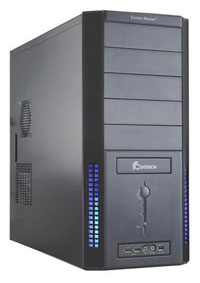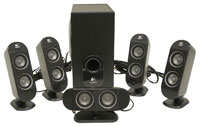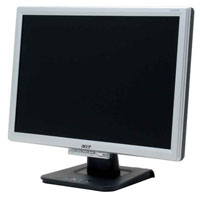Basic Configuration - Accessories
All of the components we've discussed so far tend to have more of an impact on overall system performance. What remains are the miscellaneous accessories that may not impact performance at all, but they do influence other areas of the computing environment. Personal preference will play a larger role in many of these components, so as always we would recommend people stick with what they like first and only branch out if you are looking to try something else. Most of the base selections can be used with any of the builds we will be putting together without any difficulty, and we will try to make note of any exceptions.
For optical storage, Blu-Ray and HD-DVD are still too expensive to warrant inclusion in a midrange computer, so we return to the venerable DVD+RW. Most companies now offer 18X burn speeds, which are barely faster than the old 16X maximum, and street prices bottom out at around $30. The LG GSAH22N includes all the standard features as well as 12X DVD-RAM support and works well with a variety of media, so it gets our recommendation. We're still waiting for reasonably priced SATA optical drives that can deliver similar overall quality, unfortunately.
 |
The computer case is one of the items that you will see a lot, but you really only have to work with it once or twice during the life of the typical computer (unless you upgrade frequently). Appearance is definitely an important consideration for many people, and what one person finds attractive another will find ugly or boring. Besides the appearance, the choice of case will also impact noise levels, cooling, and ease of installation. The cheapest cases tend to be made of thin steel, which gives them sharp edges internally and also makes them pretty flimsy. They will still suffice for most people, but we prefer slightly more expensive cases. Cooler Master has a large selection of reasonable midrange cases, and most of us find them to be easy to work with and reasonably attractive. Antec, In Win, Thermaltake, Apevia, Lian Li, and others offer alternatives worth considering, and if you are more budget minded the Rosewill brand is worth a look. We like cases that support 120mm fans (at least one) as they will typically offer better cooling with lower noise levels. Beyond that, remember to make sure your optical drive matches whatever case you choose.
 |
Of far more concern than the case is going to be the power supply you use, particularly in some of the upgraded midrange configurations. Getting a case with an included power supply will usually save you some money, and most power supplies rated at 350W or higher are sufficient for a midrange computer. Still, when you consider that you're spending over $1000 on all of the other components, we really hesitate to shave $40 or $50 off the total price by sticking with a low-end power supply. We've selected a reasonably priced 450W Fortron Source PSU as our basic recommendation, and that should be more than enough for any midrange computer, other than for serious overclocking. Fortron Source is a well-regarded PSU manufacturer, and they are often used as the basis of OEM power supplies. The only potential drawback of the AX450-PN is that it only has a 70% efficiency rating, but if you want a higher efficiency power supply you will have to spend more money. We're more concerned about power supply noise levels than efficiency, and while the two are related the 120mm fan used in the FSP helps to keep noise levels down. If you're willing to spend a bit more money and you want the best of both worlds - quiet and efficient - SeaSonic gets a strong recommendation. They tend to cost more for lower wattage ratings, but a SeaSonic S12-330 performs better than most other 400-450W power supplies. OCZ, Enermax, and several other companies also make some very good high-end power supplies, which we will discuss a bit further in the overclocking configuration, but SeaSonic remains one of the quietest (short of purchasing a fanless PSU).
 |
Keyboard, mouse, and speakers are three items where you can either go for the bare minimum cost and functionality, or you can spend a lot of money for extra features. We have selected what we feel are good options for all three areas, and it would be hard to find anything that's truly "better" without spending more money. Our performance configuration will include better speakers, but we didn't feel the need to upgrade the keyboard or mouse on any of the builds. If you want to get a wireless keyboard and mouse, our advice is to spend more money rather than less. The $30-$40 packages generally don't perform as well as we would like, so unless you absolutely want wireless input devices, we prefer to spend the extra money elsewhere.
 |
The last accessory is the display, and as we have said on many occasions we would much rather have a very nice display with a decent computer than to have an excellent computer with a lousy display. LCD prices have continued to drop, although even the cheapest 19" models still tend to cost just under $200. The 19" LCDs are still a good option, but for the extra money we would prefer to get a 20" LCD that comes with a higher resolution. Most of us also prefer widescreen LCDs these days, and although there are a few gaming titles that continue to cause irritation by not natively supporting widescreen resolutions, moving forward WS support should become commonplace. Outside of games, watching widescreen movies is definitely preferred, and we enjoy the extra screen width on the Windows desktop as well. Looking at the various 20" widescreen displays that are available, Acer once again has one of the best price/performance offerings. ViewSonic, BenQ, Samsung, and several other companies make similar LCDs, but they all cost a bit more and it is difficult to say that they actually look much better than the Acer model. For $230, most people will be very happy with the Acer AL2016W.
For the operating system, we selected Windows XP Media Center Edition 2005. It only costs slightly more than XP Home, and it allows you to upgrade to Vista Home Premium as we mentioned earlier. The DVR functionality may not be necessary, but it doesn't hurt either, and the only features that XP Pro adds (i.e. hard drive encryption) are not used by most people.














43 Comments
View All Comments
Mermaidman - Friday, August 31, 2007 - link
Come on guys, my AMD Barton is getting long in the tooth and UT2007 is around the corner! :)Sunrise089 - Sunday, January 21, 2007 - link
Jarred:Thanks again for another stand-out article. Despite what other may chime in (and the usual complaints by the PSU nazis that want us to spend more on a commodity component then a CPU or motherboard) this new system makes MUCH more sense than having many AMD and Intel options for what had basically become guides based on personel preference rather than rational performance. There is no reason to choose AMD for certain applications, overclocking one of them, just as there is no reason to choose Intel in others (say a sub $100 CPU). Just coming out and saying that through a build list is a wonderfull step in the right direction. I think it's crazy that users still insist on an all AMD or all Intel series of builds, when noone insists on all ATI or all nVidia.
In short, it makes much more sense to break up the builds based on the very different usage requirements - especially due to some users not OC'ing and therefore having totally different CPU, motherboard, and HSF needs than an arbitrary division of the guides based on CPU brand.
Keep up the good work!
SaII - Sunday, January 21, 2007 - link
This article has all the PSU configs wrong, get at least a GOOD branded PSU for an 8800GTSand that 700W PSU for the overclocking config is over the top over-kill.
Give the overclocking one the OCZ 600W PSU and 700W OCZ for the gaming rig.
JarredWalton - Sunday, January 21, 2007 - link
I'd say if you want a really good PSU for overclocking or gaming, plan on spending around $120 or so, which will get you the 700W OCZ listed or a variety of other high-quality 500-600W PSUs. I will take the PSU complaints under consideration next midrange guide, but seriously for gaming (WITHOUT overclocking), the only thing that really needs more than a good quality 400W PSU is going to be SLI/CrossFire setups, and even then 400W is usually enough.sirdowny - Sunday, January 21, 2007 - link
Just out of curiosity, has anyone heard about any problems with the Tuniq Tower 120 and it's massive weight? Seems like it would be a good cooler assuming it were used in a case that sat horizontally (like an HTPC), but am I the only one who has reservations about letting that brick dangle from my motherboard?SaII - Sunday, January 21, 2007 - link
I have it, it works wonders, and the only ones that have problems is user error.Zepper - Saturday, January 20, 2007 - link
Things author should know:1- Rosewill is one of Newegg's in-house packagers. Some folks won't or can't buy from Newegg/ChiefValue which is (I say is because they are the same company) the only place you can get the Rosewill brand except for perhaps some Mom & Pop shops who may buy stock from them.
2- Who actually makes that PSU so the folks referred to above can get one if they want (not that they would when such a unit as the Enhance ENP-5150GH exists with aPFC and full-range AC auto sensing is available for nearly the same money). In most cases Rosewill packages ATNG/Coolmax PSUs - if this IS a Deer then it should NEVER have been recommended - its output ratings are identical to the Coolmax 600 but the physical layout is not.
In any case, recommending Rosewill comes with risks - not the least of which is becoming a laughing stock in the community (again, if this is really a Deer then that might be well deserved). They do package some decent products like the R6A and R560x case lines - but unless you know the history of the OEM of the item, it's a pig-in-a-poke. Caveat emptor!
..bh.
Le Québécois - Saturday, January 20, 2007 - link
Are they really rebranding Deer PSU now? Do you know if any other brand use Deer as base PSU?This is the worst know brand I can think of. When I worked as a technician in a computer store, every time someone brought us a computer with a broken Deer PSU inside, almost every components of the computer had blown at the same time the PSU did. Using Deer PSU in a computer is almost like putting a time bomb in it.
mostlyprudent - Saturday, January 20, 2007 - link
Anyone know whether one of the basic configurations (AMD or Intel) from this article would perform better for a system running primarily Photoshop? I had configured two systems for a friend which are very similar to those in this article and was going to let them decide based on price and the general performance difference between the X2 3800 and E6300. It will basically be a web/email/document PC with the exception of a prosumer Photoshop user.JarredWalton - Sunday, January 21, 2007 - link
Core 2 Duo will typically be a bit faster in Photoshop, although in my opinion having a lot of RAM is more important for most professional PS work. Now if we can just get a 64-bit PS version so people can effectively use 4+ GB of memory.... :)